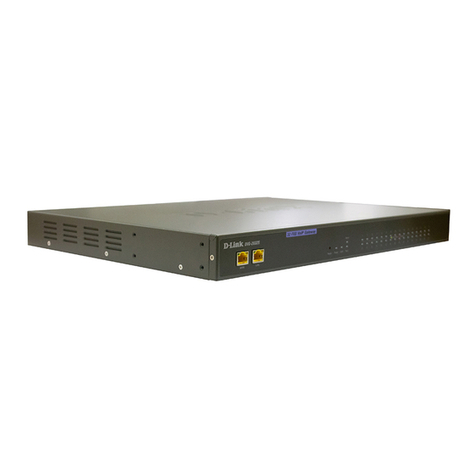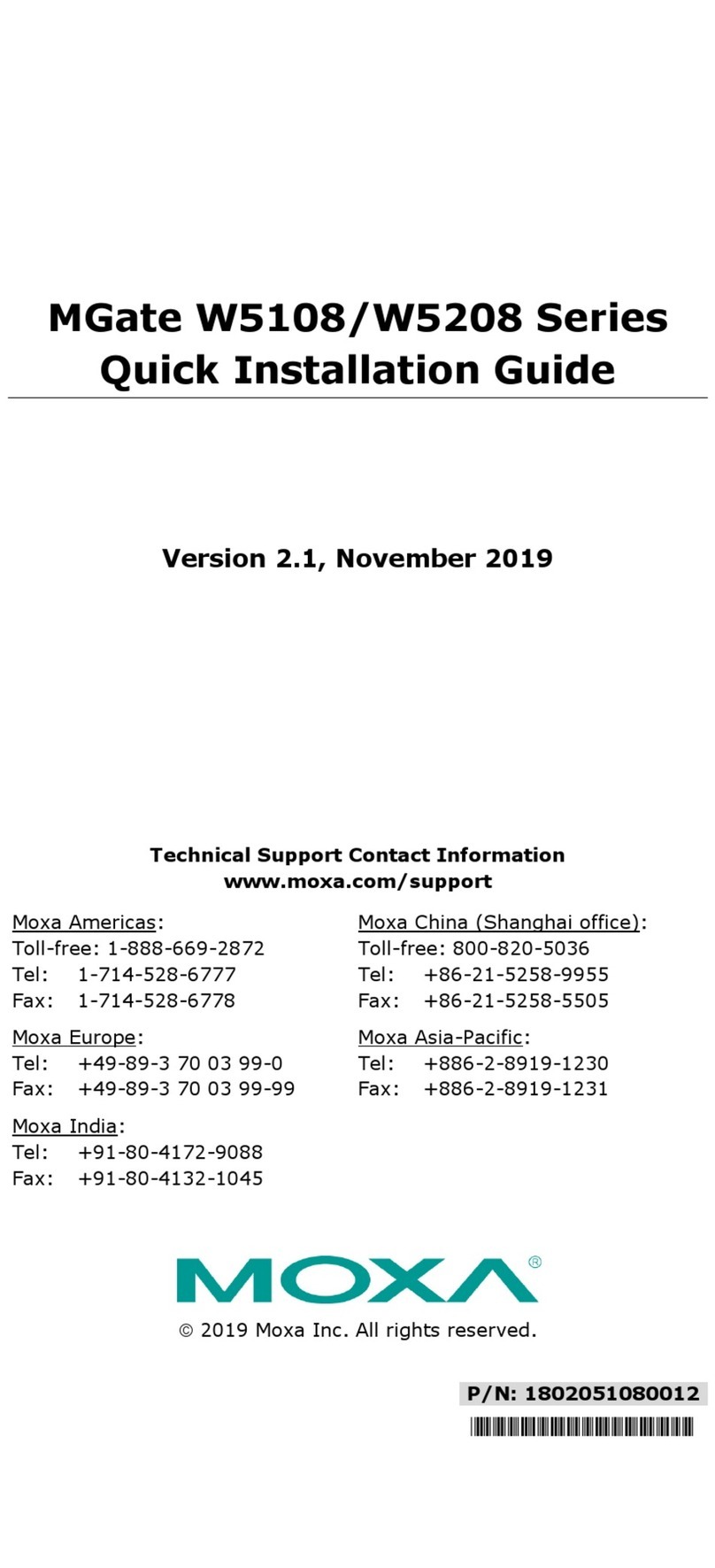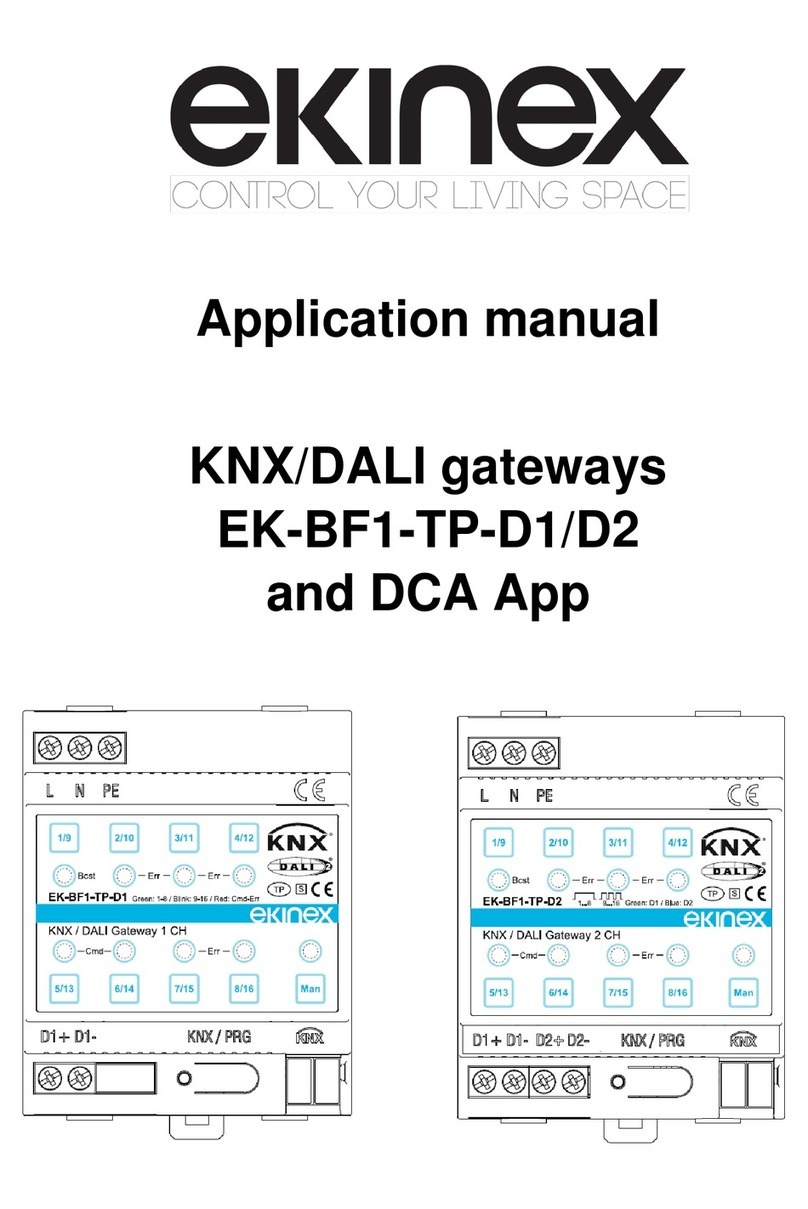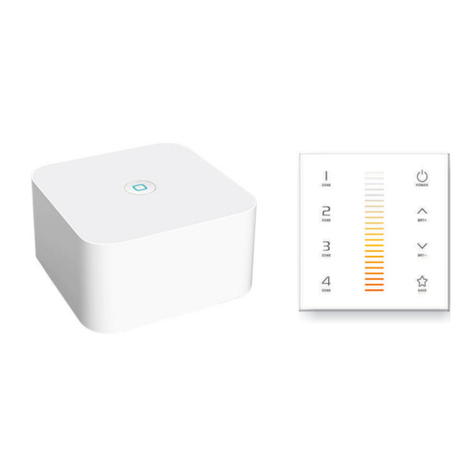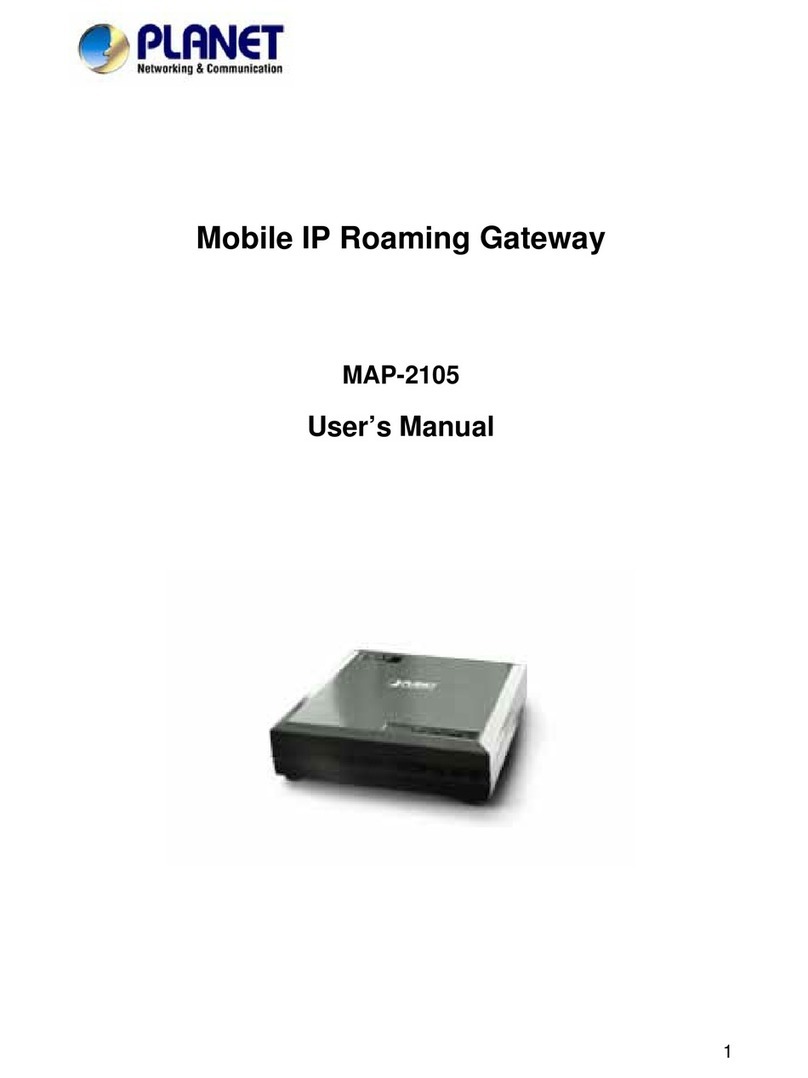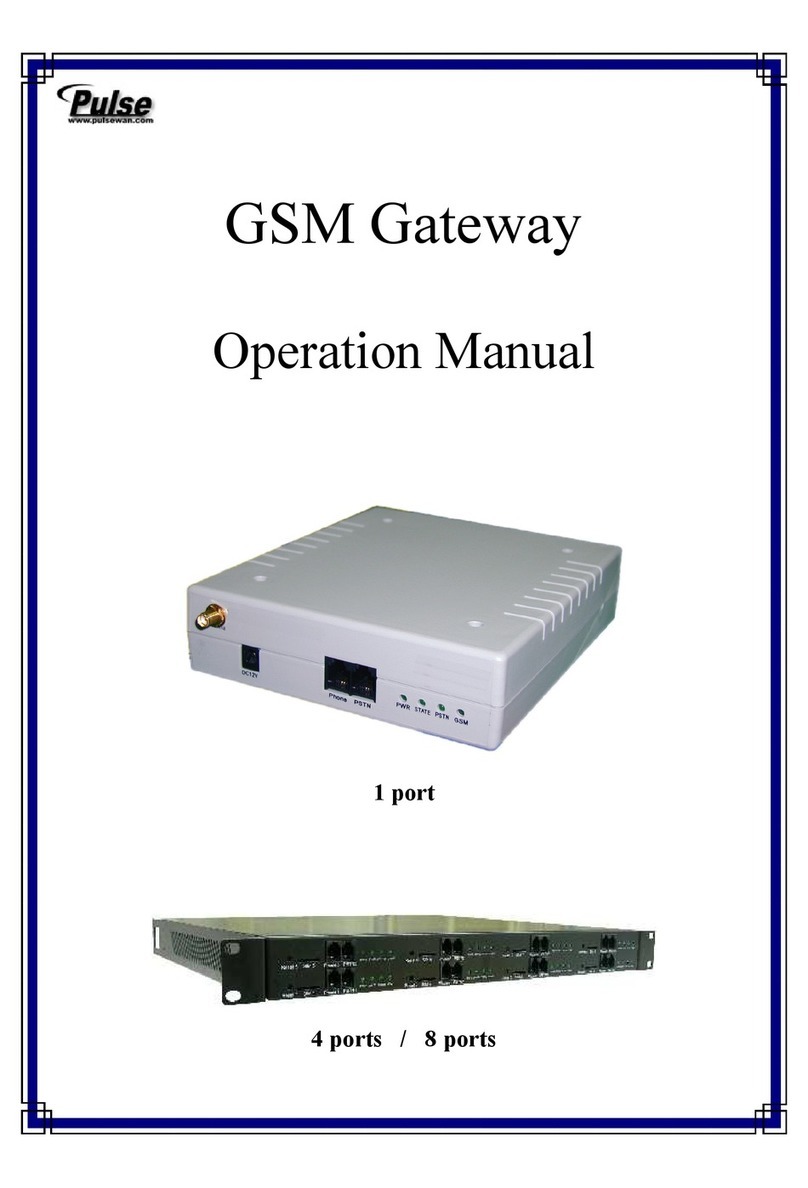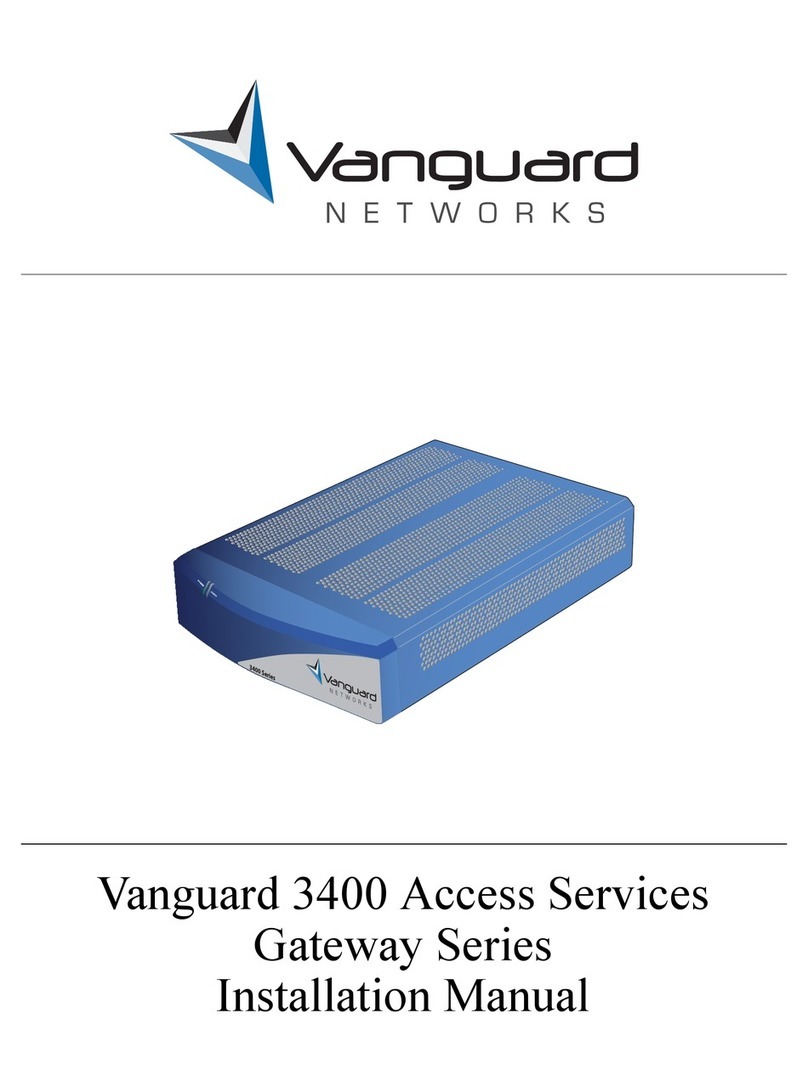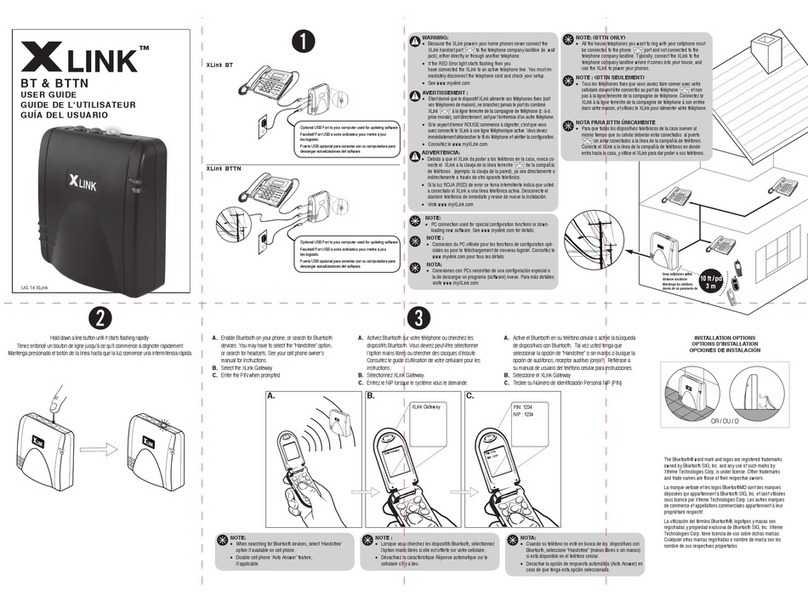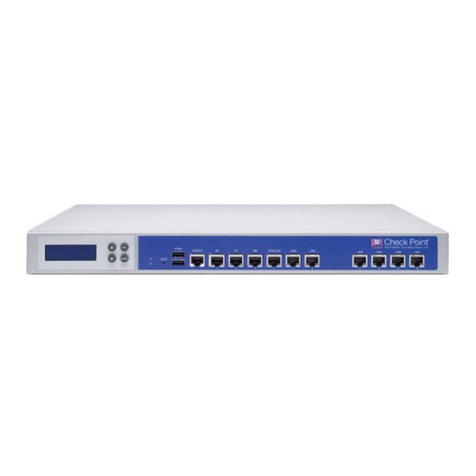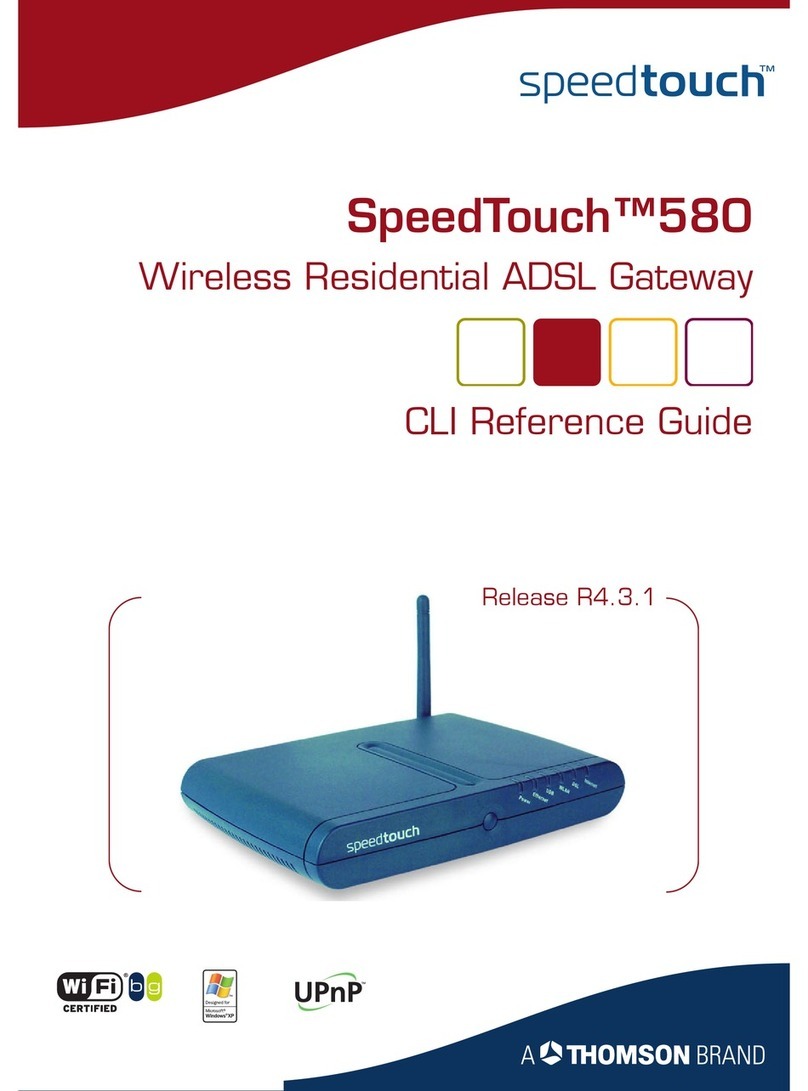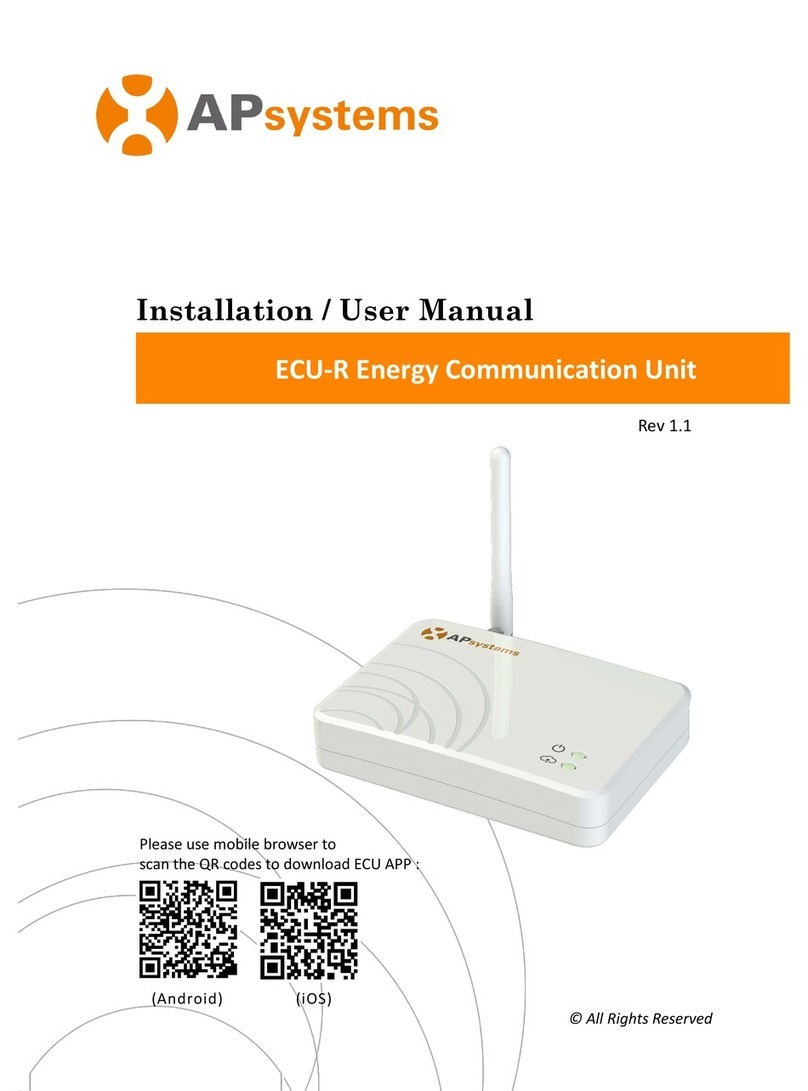GDC G-HUB User manual

Create a Monnit user account with assigned wireless gateways and sensors.
Attach the antenna to the antenna connector on the back panel of the Ethernet gateway
(make sure the connection is snug, but do not overtighten).
Plug an Ethernet cable with internet connectivity into the gateway
Plug the power supply into a power outlet then connect to the gateway.
Once all three lights turn green, your network is ready to bring sensors online.
G-HUB Ethernet Gateway Quick Start
G-HUB Wireless Sensors &
Ethernet Gateway User’s Guide
www.gdcworld.com

1. Create a G-HUB User Account and Setup Sensor Network
If this is your first time using the iG-HUB online system site, you will need to create a new ac-
count. If you have already created an account you can skip to the “Logging into the
Online System” section. The following instructions will guide you through the account cre-
ation process.
1. In a web browser, navigate to https://www.G-HUB.com.
2. Click the “Get Started Here” button to create an account.
3. Follow the on-screen instructions to enter your account and contact
information.
4. After entering your account and contact information, you will be prompted to
create your first sensor network. Simply enter a name for this network.
5. Add the information from your G-HUBLink™
gateway then click the “Assign Gateway”
button.
6a. Add the information from your first G-HUB wireless sensor then click the
“Assign Sensor” button.
+
_
Back of Sensor
Peel
Contains: FCC ID: ZTL-RFSC1
IC: 9794A-RFSC1
Sensor ID: ######
Sensor Code: XXXXXX
6b. On the next screen, enter a name for the wireless sensor and use the
drop down to tell us how you are going to be using the wireless sensor.
(This allows us to suggest settings for your sensor.) When finished, click
the “Continue” button.
PAGE 2 PAGE 3
7. Confirmation Screen.
When you have finished adding the sensor, you will see a confirmation screen. At this
point you can assign notifications to the sensor (see Using The iG-HUB™ Online Wire-
less Sensor System) , assign additional sensors to your account or click “Done” to go to
your sensors overview page.
2. Using the G-HUBLink™Ethernet Gateway
1. Understanding the Ethernet Gateway Lights
Front of Ethernet Gateway
1 2 3
Light 1 - Indicates the Ethernet cable is plugged in. A green light indicates ready and
working, a red light indicates there is a problem.
Light 2 - Indicates the Ethernet has internet connectivity and can reach the online moni-
toring system. A green light indicates ready and working, a red light indicates there is a
problem. A flashing green light indicates network traffic to the internet.
Light 3 - Indicates sensor network activity. A green light indicates ready and working, a
red light indicates there is a problem. A flashing green light indicates radio traffic from the
sensors.
For help troubleshooting Ethernet gateway lights view:
http://www.G-HUB.com/support/hardware/gateways/ethernet/troubleshooting-a-G-
HUBlink-ethernet-gateway
2. Ethernet Gateway Controls
RP SMA Antenna ConnectorEthernet PortPower Plug Control Button
Back Panel
Using the Control Button:
1) A short press will trigger the gateway to immediately send all stored sensor messages
to the online system and download any pending system messages to deliver to the sen-
sors. (The default heartbeat for the Ethernet gateway is 5 minutes.)
2) Press and hold to reset the gateway to factory settings. Factory settings will be reset
to defaults, including the heartbeat setting of 5 minutes on both the gateway and in the
online system. DHCP, server addressing and port are all restored to default settings, for
example. You will need to login to the online system after resetting the gateway to recon-
figure the gateway to your desired settings.
Note: If your gateway powers up with the lights scrolling from left to right, it has entered into boot
loader mode accidentally. Make sure the button is free from obstruction and reboot the gateway by
removing the power plug, waiting for 10 seconds then reinserting the power plug.
Contains FCC ID: ZTL-RFSC1
and IC: 9794A-RFSC1
This device complies with Part 15 of the
FCC Rules. Operation is subject to the
following two conditions:
(1) this device may not cause harmful
interference and
(2) this device must accept any interference
received, including interference that may
cause undesired operation.
ID: ######
Code: XXXXXX

3. Configuring The Ethernet Gateway
The Ethernet Gateway collects data from all sensors within range and is preconfigured to
batch deliver the sensor messages to the online system every 5 minutes.
The Ethernet Gateway uses DHCP (Dynamic Host Configuration Protocol) to
automatically acquire a network address from the LAN (Local Area Network). In the
event that it needs to have an address manually assigned to it, you can assign an IP
address as well as a gateway mask and default DNS through the online interface. For
more information on configuring the G-HUB Ethernet Gateway please view the support
documentation at http://www.G-HUB.com/pdf/Ethernet_Gateway_Configuration.pdf.
Note: This advanced configuration is NOT required in most instances. In the event that it is required,
you can initialize the gateway on a network that uses the default DHCP settings, or you can follow
the instructions for changing the configuration settings on a PC, which are included later in this User’s
Guide.
Upon logging into the online system as an administrator, select “My Account” then
choose the edit icon next to your sensor network. From there you can alter the heart-
beat of the Ethernet Gateway as well as edit any other configurations available. There is
also a quick link to reset all gateway settings to factory defaults.
3. Using Your G-HUB Wireless Sensors
Insert Batteries Into Wireless Sensors
Important: Make sure your sensors are at least 3ft. away from Ethernet Gateway.
Peel back the black sticker cover of the battery slot and slide the coin cell battery into the
sensor as shown in fig.1. It will power on within 10-20 seconds. Once online, your sensor is
ready to be deployed. If you wish to change a sensor configuration, change the parameter in
the software. The new parameters will be transmitted to the sensor on the next heartbeat. If
you need a more immediate response from the sensor, power cycle the sensor by removing,
then re-inserting the battery.
Notes:
- If the sensor status indicator does not change, reset
the sensor by removing the battery.
- Wait 60 seconds then re-insert the battery.
- When inserting the battery, make sure to push the
battery all the way back using a paper clip.
- Note the proper orientation of battery in fig.1
Warning: Your sensors ship with a 2 hour heartbeat.
It is recommended that unless you are using the AA battery
solution, you should set the heartbeat to no faster than one hour to preserve battery life. When changing
a sensor’s heartbeat, the new configuration information will be sent to the sensor on it’s next heartbeat. If
you want to update the sensors immediately you can reset them manually.
Manual Sensor Reset Process:
1 - Using the end of a paper clip, push the batteries out of the sensors through the small hole
in the top of the sensor
2 - Change the sensor heartbeat through the online system
3 - Re-insert the batteries into the sensors
PAGE 4
4. Using The iG-HUB™Online Wireless Sensor System
1. Understanding The Online Interface
When you log into the online system, the default view shows all of your sensors last
recorded data.
View / Sort FeaturesMenu System
Sensor Details ViewSensors Overview
Date Range Selector
Menu System
Overview - Shows all sensors in the account and their last readings.
Notifications - Manage sensor notifications and show all sent notifications.
Manage - Manage networks, sensors and gateways.
Reports - Printable account and sensor network reports.
Sensor Maps - Visual maps to help you track sensor placement.
Support - Support information for using sensors and software.
View / Sort Features
This section allows you to sort the sensors being viewed and search for sensors on
your account.
Sensor Overview
Displays sensors on your account with their last reading and status information. Clicking
on a sensor row expands the “Sensor Detail View” allowing you to view detailed infor-
mation for the selected sensor.
+
_
Battery
Insertion
g.1
PAGE 5

PAGE 6 PAGE 7
To the left side of each sensor row is an indicator to help you understand the current
status of the sensor.
Sensor is checking in and within user dened safe parameters.
Sensor has met or exceeded a user dened threshold or triggered event.
Sensor has not checked in (inactivity alert sent).
No sensor readings will be recorded (Inactive)
Sensor Details View
Clicking on a sensor row on the “Overview” page expands the row to include a detailed
sensor view for the selected sensor.
Select a tab to change between:
History - Displays a history of the selected sensor’s data.
Chart - Displays a graphical view of the selected sensor’s data.
Notifications - Allows you to manage notifications for the sensor.
Export - Allows you to archive data by exporting as a .csv file.
Edit - Allows you to manage sensor settings.
Calibrate - Available on certain sensor types to provide more accurate data.
Note: The data shown on the chart, notification, history and export tabs is based on the date
range indicated on the upper right side of the sensor detail information. To change the date
range, click inside the date box.
2. History and Chart Views.
Clicking on the “History” or “Chart” tabs within the sensor detail panel allows you to view
the sensor’s data history as time stamped data or in a graphical chart format.
Note: To change the date range of the viewable information, click on
the date range box at the top right of the sensor detail panel.
3. Configuring Sensor Settings
To edit a sensors operation settings, click on the sensor overview row to display the details
view. Click on the “Edit” tab to access the sensor configuration panel.
The sensor edit panel allows you to set the primary configurations for the sensor. Mousing
over the question mark icon by each setting will provide an explanation of that setting. When
you have finished making changes, press the “Save” button at the
bottom of this section.
Note: Be sure to click the “Save” button anytime you make a change to any of the sensor parameters.
All changes made to the sensor settings will be downloaded to the sensor on the next sensor heartbeat
(check-in). Once a change has been made and “Saved,” you will not be able to edit that sensor’s configu-
rations again until the sensor has downloaded the new setting.

4. Sensor and/or Gateway Notification(s).
Notifications for a single sensor can be created, deleted or edited by clicking the
“Notifications” tab in a sensor’s detail view.
Notifications can be created, deleted or edited for any sensor or group of sensors by click-
ing on “Notifications” in the main menu.
Toggle On/Off Click to Open Detail View Send Test Edit Delete
When creating a notification, you will need to select the type of notification to create.
• Sensor Reading Notification - Reading notifications are sensor specific (i.e. water sen-
sor = trigger alert when water present, temp sensor = trigger alert when temp is above
70F, etc.). When creating a sensor reading notification, you will need to choose the
sensor type you are creating the alert for. The select box will only show sensor types
that are currently being used on your sensor network.
• Battery Notification - Allows users to define a battery power percentage level that will
trigger an alert from the system, warning them to replace batteries.
• Inactivity Notification - Set-up “Inactivity” notifications to alert you when your sensors
have stopped communicating with the servers. Failure to set up an “Inactivity” notifi-
cation will result in no email/SMS text being sent should your sensors stop communi-
cating with the servers.
• Advanced Notifications - Allows the user to set notifications based on advanced rules,
such as comparing past data points with the current one to determine if a notification
should be sent.
• Existing Notifications - Use notifications that have already been created on your ac-
count with the selected sensor.
Notification Settings
This area allows the user to set notification parameters such as naming the
notification, customizing the notification message and setting sensor conditions that will
trigger the notification.
People to Notify
The list on the left shows all available users on the account. You can type into the search
box to filter large lists of users. Select the user(s) to receive the notification and click the
arrow button to add them to the recipient list. By default, email notifications are activated.
Clicking the notification delivery method icon toggles them on and off (green is on, grey is
off). If the user should receive text message notifications, click on the phone icon to turn it
green.
Sent From
Allows you to assign devices (sensors and gateways) that will cause the notification to be
sent. When a notification is sent from the system, it will automatically include the device
name and the data that caused the notification to be sent. A single notification can be
assigned to multiple sensors or gateways. Sensor reading notifications can only be as-
signed to sensors of the same type. General notifications such as “battery status”, can be
assigned to any or all sensors.
PAGE 8 PAGE 9
Create a New
Notication

Certain wireless sensors can be calibrated for more accurate readings (ex. temperature
sensors). If calibration is possible for a sensor, the “Calibrate” tab will be visible in the detail
view. To calibrate a sensor, replace the last reading with the more accurate reading and click
“Calibrate”. All future readings from the sensor will be based off the new calibration setting.
7. Manage Sensor Networks
To view or edit information about your wireless sensor network(s), click on “Manage” in the
main navigation. This area allows you to edit network details, create new sensor networks,
and manage wireless gateways and sensors for your network(s).
PAGE 11
Move device to
another network
Add a device
to the network
Create a
new network
Remove device
from network
Edit network
information
Clear sensor
history and data
Click to
Manage
Select which
network to view
Note: Some buttons and features are only visible if there is more than one sensor network setup on the
account, such as the network selection box in the upper right corner.
If more than one sensor network is setup on the account, you can easily move gateways and sensors from
one network to another by clicking on the “Move Device” button at the far right of the device’s “Status”
section.
If you clear a sensor’s data, the data history is deleted from the entire system and can not be recovered. We
recommend exporting a sensor’s data history using the export function in the sensor details view
(“Overview” page) before clearing the sensor’s data if you want to have a record of the data.
PAGE 10 PAGE 11
Devices to Notify
If you have a G-HUB Control or Notifier A/V device on your network, you will also see
a “Devices to Notify” tab. This will allow the notification to interact with these types of
devices. Select a device from the list on the left and click the arrow button to add it to the
recipient list. Clicking the control icon toggles their setting.
Note: Control devices have two relays per device that are controlled separately. You can turn a relay on,
off or toggle the state. You can also set a duration by clicking on the timer icon. This will perform the
selected toggle (on/off/toggle) for a set duration, then change back.
5. Exporting Sensor Data
Clicking on the “Export” tab within the sensor data window allows you to export sensor data
to a comma separated value (.csv) file or send the sensor data to an external web source.
To export sensor data you must first select the date range for the data you want to export.
Once the date range is selected, determine whether you want sensor data from the
selected sensor only, from all sensors in the network or all sensors assigned to the account.
When you are finished, click on “Export Data” at the bottom of this window. The data will be
exported to a comma separated value (.csv) file format. Note: Only the first 2,500 records within the
selected date range will be exported.
You can alternately send your sensors’ incoming data to a 3rd party by clicking on the “Con-
figure data push” button at the bottom of the window. From this area you can pass data from
your wireless sensor network devices to another service in real time. This is done by coding
the data into a url query then sending the data via http get request at the time data is received.
There is an extensive list of parameters that can be passed, as listed in the viewed window,
that allow you to send detailed information about both the data and the sensor.
6. Calibrating Sensor Data

To set the Static IP, uncheck the Use DHCP box and fill in the settings:
The force transmit on Aware box tells the gateway to deliver immediately the messages
marked as Aware from the sensors. If this box is unchecked and the setting is saved,
then the gateway only dumps the sensor messages it has been collecting on the Heart-
beat Interval. This allows for controlled communication when sporadic communication
from the gateway is either unacceptable or not ideal.
2. External Interfaces:
Data collected by the Ethernet Gateway from the sensors in the network can be accessed
when these interfaces are turned on. Multiple interfaces can be active at the same time.
All interfaces require that the Ethernet gateway be set to a Static IP address. (By default,
the unit uses DHCP).
Real Time TCP Interface
Poll on the gateway’s assigned port to retrieve gateway and sensor data.
Mark the interface active and Save. The default port is 3500, but can be edited.
PAGE 12 PAGE 13
5. Advanced Settings and Interfacing with the G-HUB Ethernet
Gateway Through iG-HUB.
1. Ethernet Gateway Edit Screen
When you log into the online system, the default view shows all of your sensors last
recorded data.
The name can be edited to whatever you prefer.
The gateway type should NOT be edited, unless you are directed to do so by a G-HUB
Support Representative.
The unit’s MAC Address is viewable here, should you need to access it.
The heartbeat dictates how often the gateway communicates with the server. This is both
for communication passed up to the server from the gateway and the communication
passed to the gateway from the server. Exceptions to this interval include Aware mes-
sages from sensors.
The Enterprise Server Host address and Communication Port will always be one of G-
HUB’s servers and ports by default, but should you require that the gateway be pointed
to your private servers, the gateway can be configured to do so. Make sure to set the
appropriate port as well, if port 3000 will not be used.

Data 1 Sensor Data Field 1 40109 108
Data 2 Sensor Data Field 2 40110 109
Data 3 Sensor Data Field 3 40111 110
Data 4 Sensor Data Field 4 40112 111
Data 5 Sensor Data Field 5 40113 112
Data 6 Sensor Data Field 6 40114 113
Data 7 Sensor Data Field 7 40115 114
Data 8 Sensor Data Field 8 40116 115
SNMP Poll and Trap Interface
Use SNMP software to pull in gateway and sensor data. G-HUB provides a .MIB file.
There are four available interfaces. Set the SNMP Interface Address for each one the ad-
dress of the device sending the SNMP request). Mark the interface Active and Save.
The MIB file is available through here:
resources.G-HUB.com/content/downloads/G-HUBEGW-MIB_v1
The MIB Tree looks like this:
PAGE 14 PAGE 15
MODBUS TCP Interface
Use MODBUS TCP software to pull in gateway and sensor data. G-HUB provides a regis-
ter map. Check the box to make the interface Active and Save.
The MODBUS TCP Interface will store all data values in 16-bit registers. The registers and
their data fields are mapped below:
Field Description Register Data
Address
GATEWAY Gateway ID_High The rst 16 bytes of a 32 byte
serial ID number
40001 0
REGISTERS Gateway ID_Low The last 16 bytes of a 32
bytes serial ID number
40002 1
Gateway Version The version of gateway
rmware on the device
40003 2
Gateway Device
Count
The number of devices
(sensors & gateways) in its
network
40004 3
SENSOR Sensor ID_High The rst 16 bytes of a 32 byte
serial ID number
40101 100
REGISTERS Sensor ID_Low The last 16 bytes of a 32
bytes serial ID number
40102 101
Device Type The unique type identier for
the sensor prole
40103 102
Data Age The number of seconds that
have elapsed since the last
data was retrieved
40104 103
Is Device Active 0 indicates no data for this
slot
40105 104
Is Aware Becomes aware when a
sensor threshold has been
breached
40106 105
Voltage Battery voltage 40107 106
RSSI Signal Strength indicator
0-100%
40108 107

6. Setting up the Ethernet gateway for use with iG-HUB Express
iG-HUB Express (PC Software) Setup
Visit http://www.G-HUB.com/support/downloads/ to download and install the iG-HUB
Express software.
• Launch the iG-HUB Express installer and follow the on-screen instructions.
• Launch the iG-HUB Express program.
• Activate the Express software with the code you received when purchasing.
• Add the gateway(s) and wireless sensors to the software.
Contains FCC ID: ZTL-RFSC1
and IC: 9794A-RFSC1
This device complies with Part 15 of the
FCC Rules. Operation is subject to the
following two conditions:
(1) this device may not cause harmful
interference and
(2) this device must accept any interference
received, including interference that may
cause undesired operation.
ID: ######
Code: XXXXXX
• Verify that the gateway was added successfully by checking the Gateways list.
PAGE 16 PAGE 17
Ethernet Gateway MIB tree with a short description of each field:
EGW Data Description
*GW Section Gateway Section
*GW Serial Gateway Serial ID
*Version Gateway Firmware Version
*WD Count Wireless Device Count
*WNetSection Wireless Network Seciont
*WD Entry Wireless Device Entry
*Index Index Number
*Serial Wireless Device Serial ID
*Type Device Type (eg temp, water, motion sensor, etc)
*Age Number of seconds since last data recording
*Active Indicates if the wireless device is reporting in as expected
*Alarming Indicates if the wireless device has detected data that is urgent or
breaches a threshold
*Voltage Battery voltage recorded at the time of data reading
*RFSignal Signal Strength recorded on data reading delivery
*Data1 Data recorded by wireless device (eg temperature, water de-
tected, motion detected, etc)
*Data2 Data recorded by wireless device (eg temperature, water de-
tected, motion detected, etc)
*Data3 Data recorded by wireless device (eg temperature, water de-
tected, motion detected, etc)
*Data4 Data recorded by wireless device (eg temperature, water de-
tected, motion detected, etc)
*Data5 Data recorded by wireless device (eg temperature, water de-
tected, motion detected, etc)
*Data6 Data recorded by wireless device (eg temperature, water de-
tected, motion detected, etc)
*Data7 Data recorded by wireless device (eg temperature, water de-
tected, motion detected, etc)
*Data8 Data recorded by wireless device (eg temperature, water de-
tected, motion detected, etc)

• When finished, click the “Reboot” button on the top right side of the page to restart the
gateway.
• When the lights begin flashing on the gateway, you can unplug the power to the gateway
and disconnect it from the computer.
• Reactivate the Wi-Fi or other Internet connection for the computer, so it can connect to
the network.
• Plug your Ethernet gateway into your Internet router and power up the Ethernet
gateway. All three lights should go green now, and your gateway should report into G-
HUB Express.
If it does not, check that the PC has the internet connection turned on, recheck your IP
Address, power up your gateway and make sure the gateway is added into G-HUB
Express. (If you left your secondary set to point to sensorsgateway.com (which is
iG-HUB) and the lights on your gateway are green, check iG-HUB to see if the gateway is
reporting in there. If so, power cycle the gateway and try again.)
PAGE 18 PAGE 19
• Click on “About”, then “Local IP Addresses” and make note of the IP address that your
computer is using on your network.
• Connect the Ethernet Gateway directly to the Ethernet port of your PC using a standard
Ethernet cable. Confirm that the PC has no other internet connection (turn off Wi-Fi).
Confirm the PC firewall does not prohibit an inbound connection. Plug power cable into
the Ethernet gateway.
• Plug in the power cable.
• While the device is booting, press and hold the Reset Button on the back of the gateway.
The button must be held in the down position by the time the third green light illuminates,
or else another attempt will need to be made. When the device finishes booting, all three
lights will toggle red, green. Release the button and the device is in local configuration
mode. Do not hold the Reset button for more than four seconds (that will factory reset the
device).
The lights will flash green once every other second while the device attempts to resolve
Ethernet Link State. The lights will flash green once every second while the device at-
tempts to resolve IP addresses with the host PC. Finally, the lights will flash green twice
every second when device is waiting for valid web traffic.
• Once the PC has setup the direct network, use a web browser (e.g. Chrome) and go to
“192.168.100.1”. The Ethernet gateway Setup screen should now be displayed.
Note: The lights will all turn solid green once this connection has been established.
• Click on the “Data Interfaces” tab.
• Under “Default Server Configuration” enter the IP address that you noted from the iG-HUB
Express software into the primary and secondary server [URL/IP] boxes, and use 3000 as
the default communication port, then click “Save Changes”.

Error Reporting, Troubleshooting and Support
For technical support and troubleshooting tips please visit our support
library online at http://www.G-HUB.com/support/. If you are unable to
solve your issue using our online support, email G-HUB support at
[email protected] with your contact information and a description
of the problem, and a support representative will call you within one
business day.
For error reporting, please email a full description of the error to
Warranty Information
(a) G-HUB warrants that G-HUB-branded products will be free from defects in materials
and workmanship for a period of one (1) year from the date of delivery with respect to hard-
ware and will materially conform to their published specications for a period of one (1) year
with respect to software. G-HUB may resell sensors manufactured by other entities and are
subject to their individual warranties; G-HUB will not enhance or extend those warranties.
G-HUB does not warrant that the software or any portion thereof is error free. G-HUB will
have no warranty obligation with respect to Products subjected to abuse, misuse, negli-
gence or accident. If any software or rmware incorporated in any Product fails to conform
to the warranty set forth in this Section, G-HUB shall provide a bug x or software patch
correcting such non-conformance within a reasonable period after G-HUB receives from
Customer (i) notice of such non-conformance, and (ii) sufcient information regarding such
non-conformance so as to permit G-HUB to create such bug x or software patch. If any
hardware component of any Product fails to conform to the warranty in this Section, G-HUB
shall, at its option, refund the purchase price less any discounts, or repair or replace non-
conforming Products with conforming Products or Products having substantially identical
form, t, and function and deliver the repaired or replacement Product to a carrier for land
shipment to customer within a reasonable period after G-HUB receives from Customer (i)
notice of such non-conformance, and (ii) the non-conforming Product provided; however,
if, in its opinion, G-HUB cannot repair or replace on commercially reasonable terms it
may choose to refund the purchase price. Repair parts and replacement products may be
reconditioned or new. All replacement products and parts become the property of G-HUB.
Repaired or replacement products shall be subject to the warranty, if any remains, originally
applicable to the product repaired or replaced. Customer must obtain from G-HUB a Return
Material Authorization Number (RMA) prior to returning any Products to G-HUB. Products
returned under this Warranty must be unmodied.
Customer may return all Products for repair or replacement due to defects in original mate-
rials and workmanship if G-HUB is notied within ninety (90) days of customer’s receipt of
the product. G-HUB reserves the right to repair or replace products at its own and complete
discretion. Customer must obtain from G-HUB a Return Material Authorization Number
(RMA) prior to returning any products to G-HUB. Products returned under this Warranty
must be unmodied and in original packaging. G-HUB reserves the right to refuse warranty
repairs or replacements for any products that are damaged or not in original form. For
products outside the ninety-day warranty period repair services are available at G-HUB at
standard labor rates for a period of one year from the Customer’s original date of receipt.
(b) As a condition to G-HUB’s obligations under the immediately preceding paragraphs,
Customer shall return Products to be examined and replaced to G-HUB’s facilities, in ship-
ping cartons which clearly display a valid RMA number provided by G-HUB. Customer ac-
knowledges that replacement products may be repaired, refurbished or tested and found to
be complying. Customer shall bear the risk of loss for such return shipment and shall bear
all shipping costs. G-HUB shall deliver replacements for Products determined by G-HUB
to be properly returned, shall bear the risk of loss and such costs of shipment of repaired
products or replacements, and shall credit Customer’s reasonable costs of shipping such
returned Products against future purchases.
(c) G-HUB’s sole obligation under the warranty described or set forth here shall be to repair
or replace non-conforming products as set forth in the immediately preceding paragraph,
or to refund the documented purchase price for non-conforming Products to Customer. G-
HUB’s warranty obligations shall run solely to Customer, and G-HUB shall have no obliga-
tion to customers of Customer or other users of the Products.
Limitation of Warranty and Remedies.
THE WARRANTY SET FORTH HEREIN IS THE ONLY WARRANTY APPLICABLE TO
PRODUCTS PURCHASED BY CUSTOMER. ALL OTHER WARRANTIES, EXPRESS
OR IMPLIED, INCLUDING BUT NOT LIMITED TO THE IMPLIED WARRANTIES OF
MERCHANTABILITY AND FITNESS FOR A PARTICULAR PURPOSE ARE EXPRESSLY
DISCLAIMED. G-HUB’S LIABIITY WHETHER IN CONTRACT, IN TORT, UNDER ANY
WARRANTY, IN NEGLIGENCE OR OTHERWISE SHALL NOT EXCEED THE PURCHASE
PRICE PAID BY CUSTOMER FOR THE PRODUCT. UNDER NO CIRCUMSTANCES
SHALL G-HUB BE LIABLE FOR SPECIAL, INDIRECT OR CONSEQUENTIAL DAM-
AGES. THE PRICE STATED FOR THE PRODUCTS IS A CONSIDERATION IN LIMITING
G-HUB’S LIABILITY. NO ACTION, REGARDLESS OF FORM, ARISING OUT OF THIS
AGREEMENT MAY BE BROUGHT BY CUSTOMER MORE THAN ONE YEAR AFTER
THE CAUSE OF ACTION HAS ACCRUED.
IN ADDITION TO THE WARRANTIES DISCLAIMED ABOVE, G-HUB SPECIFICALLY DIS-
CLAIMS ANY AND ALL LIABILITY AND WARRANTIES, IMPLIED OR EXPRESSED, FOR
USES REQUIRING FAIL-SAFE PERFORMANCE IN WHICH FAILURE OF A PRODUCT
COULD LEAD TO DEATH, SERIOUS PERSONAL INJURY, OR SEVERE PHYSICAL OR
ENVIRONMENTAL DAMAGE SUCH AS, BUT NOT LIMITED TO, LIFE SUPPORT OR
MEDICAL DEVICES OR NUCLEAR APPLICATIONS. PRODUCTS ARE NOT DESIGNED
FOR AND SHOULD NOT BE USED IN ANY OF THESE APPLICATIONS.
PAGE 20 PAGE 21

Certications
United States FCC
This equipment has been tested and found to comply with the limits for a Class B digital
devices, pursuant to Part 15 of the FCC Rules. These limits are designed to provide
reasonable protection against harmful interference in a residential installation. This
equipment generates, uses, and can radiate radio frequency energy and, if not installed
and used in accordance with the instruction manual, may cause harmful interference to
radio communications. However, there is no guarantee that interference will not occur in
a particular installation. If this equipment does cause harmful interference to radio or
television reception, which can be determined by turning the equipment off and on, the
user is encouraged to try to correct the interference by one of more of the following
measures:
• Reorient or relocate the receiving antenna
• Increase the separation between the equipment and receiver
• Connect the equipment into an outlet on a circuit different from that to which
the receiver is connected.
• Consult the dealer or an experienced radio/TV technician for help.
Warning: Changes or modications not expressly approved by G-HUB could void
the user’s authority to operate the equipment.
RF Exposure
G-HUB Wireless Sensors and Ethernet Gateway Contain: FCC ID: ZTL-RFSC1
This device has been designed to operate with an approved antenna listed below, and
having a maximum gain of 5.1 dBi. Antennas not included in this list or having a gain
greater than 5.1 dBi are strictly prohibited for use with this device. The required antenna
impedance is 50 ohms.
To reduce potential radio interference to other users, the antenna type and its gain should
be so chosen that the equivalent isotropically radiated power (EIRP) is not more than that
required for successful communication.
Approved Antennas
The following antennas are approved for use with G-HUB devices.
• Hyperlink HG905RD-RSP (5.1 dBi Rubber Duck)
• Pulse W1063 (3.0 dBi Rubber Duck)
• ChangHong GSM-09 (2.0 dBi Rubber Duck)
• Specialized Manufacturing MC-ANT-20/4.0C (4” whip)
WARNING: To satisfy FCC RF exposure requirements for mobile
transmitting devices, the antenna used for this transmitter must not be
co-located in conjunction with any other antenna or transmitter.
PAGE 22 PAGE 23
Canada (IC)
English
Under Industry Canada regulations, this radio transmitter may only operate using an
antenna of a type and maximum (or lesser) gain approved for the transmitter by Industry
Canada. To reduce potential radio interference to other users, the antenna type and its gain
should be so chosen that the equivalent isotropically radiated power (e.i.r.p.) is not more
than that necessary for successful communication.
The radio transmitter (IC: 9794A-RFSC1) has been approved by Industry Canada to oper-
ate with the antenna types listed below with the maximum permissible gain and required
antenna impedance for each antenna type indicated. Antenna types not included in this list,
having a gain greater than the maximum gain indicated for that type, are strictly prohibited
for use with this device.
This device complies with Industry Canada licence-exempt RSS standard(s). Operation is
subject to the following two conditions: (1) this device may not cause interference, and (2)
this device must accept any interference, including interference that may cause undesired
operation of the device.
French
Conformément à la réglementation d’Industrie Canada, le présent émetteur radio peut
fonctionner avec une antenne d’un type et d’un gain maximal (ou inférieur) approuvé pour
l’émetteur par Industrie Canada. Dans le but de réduire les risques de brouillage radioélec-
trique à l’intention des autres utilisateurs, il faut choisir le type d’antenne et son gain de
sorte que la puissance isotrope rayonnée équivalente (p.i.r.e.) ne dépasse pas l’intensité
nécessaire à l’établissement d’une communication satisfaisante.
Le présent émetteur radio (IC: 9794A-RFSC1) a été approuvé par Industrie Canada pour
fonctionner avec les types d’antenne énumérés ci-dessous et ayant un gain admissible
maximal et l’impédance requise pour chaque type d’antenne. Les types d’antenne non inc-
lus dans cette liste, ou dont le gain est supérieur au gain maximal indiqué, sont strictement
interdits pour l’exploitation de l’émetteur.
Le présent appareil est conforme aux CNR d’Industrie Canada applicables aux appareils
radio exempts de licence. L’exploitation est autorisée aux deux conditions suivantes : (1)
l’appareil ne doit pas produire de brouillage, et (2) l’utilisateur de l’appareil doit accepter
tout brouillage radioélectrique subi, méme si le brouillage est susceptible d’en comprom-
ettre le fonctionnement.
Industry
Canada

Additional Information and Support
For additional information or more detailed instructions on how to use your
G-HUB Wireless Sensors or the iG-HUB Online System, please visit us on the
web at http://www.G-HUB.com/support/.
Global Design Corporation Inc
67 East Park Place Suite 750, Morristown NJ 07960, United States
Table of contents
